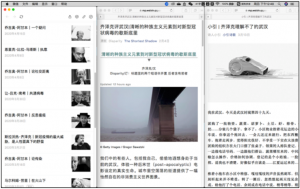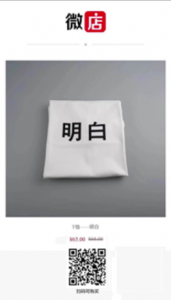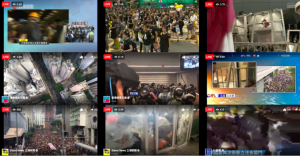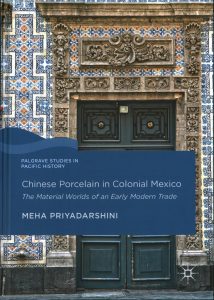CAA News Today
International News: Letters from Asia Art Archive Under Lockdown (Part I)
posted by Allison Walters — November 10, 2020
The following article was written in response to a call for submissions by CAA’s International Committee. It is by John Tain, Congyang Xie, Michelle Wong, Cici Wu, and Noopur Desai, all researchers at Asia Art Archive.
Introduction, John Tain, Head of Research, Asia Art Archive
In the first few months of this year, one thing that became clear was how deeply divided the world remained and remains, even as globalization brought us all closer physically and virtually. There have been of course the many overt racist acts around the world, and also the less visible but no less insidious effects of structural racism on individuals and communities of color. There also remains plain ignorance reinforced by geography. In long distance calls and video meetings, it became clear that what people across Asia recognized right away as a cataclysmic life-or-death disaster remained literally and figuratively a faraway concern for many people in the United States and Europe—until it wasn’t anymore.
At Asia Art Archive (AAA), we have seen the drama unfolding firsthand in both Asia and North America. Our colleagues in Shanghai went into lockdown almost as soon as the news came out of Wuhan, with our main office in Hong Kong soon to follow. For those first few weeks, outpourings of concern, sympathy, and sometimes curiosity accompanied the daily news and dreaded case tallies. Then, as the pandemic spread, it was our colleagues in New York and then New Delhi who were hit, along with the rest of the world, and it became our turn to send support and supplies when possible. We had already been in the habit of meeting regularly on Zoom as a way to work across distances, but throughout these months, talking with one other online became about more than work. It became a way to bridge the chasms keeping us apart all the more now. It is in the spirit of those conversations that I have asked my colleagues to share their thoughts, as reminders that whatever the disparities, we must deal with this together.
The Pandemic and Politics, Congyang Xie, Research Associate, Asia Art Archive, Shanghai
In early February, two weeks after the shutdown of Wuhan due to the outbreak of the coronavirus, an article was published by Slovenian philosopher Slavoj Žižek titled “Clear Racist Element to Hysteria over New Coronavirus.” Translated into Chinese and circulated through the social media platform WeChat, it quickly became one of the most widely shared texts among contemporary art practitioners in Mainland China. Žižek, who has built a large readership in China over the last decade, began by saying that “Some of us, including myself, would secretly love to be in China’s Wuhan right now, experiencing a real-life, post-apocalyptic movie set.” (https://www.rt.com/op-ed/479970-coronavirus-china-wuhan-hysteria-racist/)
More challenging statements followed. Unsurprisingly, there were all kinds of reactions within the art world, which amplified when more articles were published and circulated via WeChat by other Western thinkers who are more or less known to Chinese art practitioners, including Jean-Luc Nancy, Jacques Rancière, and especially Giorgio Agamben (Fig. 1). But the controversies around Žižek were particularly interesting. If Žižek’s text, as many have pointed out, disregarded the local context in China, the reading and sharing of the article in Chinese was also decontextualizing. The (re-)awareness of the very existence of intellectual borders that so many people tried hard to ignore may be one of the by-products of COVID-19.

Figure 1. Left: A WeChat account publishing translated articles by various Western philosophers regarding the pandemic. Middle: Screenshot of Žižek’s article published in Chinese. Right: Screenshot of an article by Chinese poet Xiao Yin, titled “The Wuhan City That Žižek Cannot Understand”. Photo provided by the author.
Reading the text in a literal way, Žižek’s fiercest critics denounced the philosopher as naïve, if not delusional, for saying the situation in Wuhan was desirable, for ignoring the real tragedy in Wuhan, and for being indifferent to the dead and to those who were still suffering. Such opinion is based upon a humanistic attitude. The most extreme camp, however, went so far as to reach a nationalist point of view, concluding that Westerners never understand what is happening in China, and that Western theories are irrelevant and not applicable to China’s problems.
Another group of critics, non-nationalists, with a more liberal mindset, were thus highly attentive to Žižek’s call for “a new form of what was once called Communism.” Based on modern and contemporary history of China, this group considers Communism as just the flip side of the coin of authoritarianism. Taking individual freedom as a priority, this group worried that the activity-monitoring technologies used by the government in the name of containing the epidemic would eventually normalize and strengthen total governmental control over society, even after the epidemic ends.
This critical attitude towards authority was shared by a third group of people, who would agree at least partially with Žižek, citing his words that “If there were people in China who attempted to downplay epidemics, they should be ashamed.” In fact, during the first days of the coronavirus outbreak, transparency from authorities was the strongest demand from all of China’s social groups. The protest reached a peak when Li Wenliang, the whistleblower doctor who was forced to keep silent by authorities, was reported to have passed away from the deadly disease on February 7. That night, lit-candle emojis were all over social media. In response to the event, artist Zhang Peili designed a minimalist set of two T-shirts, which are worn frequently by artists and visitors to exhibitions (Fig. 2).

Figure 2. Online shop selling T-shirt designed by Zhang Peili. The text means “I understand.” Photo provided by the author.
The debates highlight the ideological conflicts in China that have only intensified under the pandemic, though more space would be needed to map the full spectrum of opinions. Perhaps what makes Žižek’s text so appealing to art practitioners in China in the first place is the claim that “there is, however, an unexpected emancipatory prospect hidden in this nightmarish vision,” even if people may have (mis)understood it in a thousand different ways.
Separate yet Together, Michelle Wong, former Researcher, Asia Art Archive, Hong Kong

Figure 1. Screenshot of news livestream, July 1, 2020. Photo provided by the author.
One evening in March 2020, when Hong Kong’s first wave of COVID-19 cases was subsiding, we sat in a friend’s studio to look at the image archive of an artist-run space. “100 Square Feet Park,” or the Park, as we affectionately call it, was once a storefront on Lai Chi Kok Road, facing busy traffic. The image we were looking at was of a documentary exhibition from the Umbrella Movement of 2014. A monitor was placed on a table facing the street level. Pedestrians walking by wondered whether the images shown in the monitor were live or documentary images. It struck me at that 2020 moment, as we looked at the image five years on, that I had forgotten how it felt when livestreaming news—of marches, of roads puffing with smoke, of sparks flying out from long tubes, of people in all sorts of uniforms running—was not yet a norm. I remember an inexplicably overwhelming feeling of looking at the nine images on the split-screen livestreaming for the first time, and I thought my simmering anger would rise to the boiling point if I saw one more Instagram post that attempted to theorize this over-mediation.
For some time now I have pondered the morbidity that is part and parcel of my vocation as a researcher at AAA. It is only half a joke when I describe my job as “talking to old(er) people and working on dead people stuff”. On various occasions I have described archives as haunted and haunting, trains for zombies, and repositories for art that could be undead. I still think about these things when I peer and squint at my computer screen while on Zoom/Jitsi/Skype. During the time leading up to the pandemic, and perhaps also during it (i.e. now), I think often about a generation of practitioners, many of them friends and colleagues who I have met through my work at AAA. I think of how these people, myself included, have knowingly or unknowingly committed ourselves to remembering other people’s lives. Everyone who tells stories of other people’s lives, in this case through dealing with their archives, is learning how to do so along the way, much like writers learning how to write. And as we remember these lives and tell these stories, our stories can become entangled with theirs. Sometimes, it is nice to know you can choose not to do it alone.
Affiliated Society News: November 2020
posted by Allison Walters — November 06, 2020
Affiliated Society News shares the new and exciting things CAA’s affiliated organizations are working on including activities, awards, publications, conferences, and exhibitions.
Interested in becoming an Affiliated Society? Learn more here.
American Institute for Conservation
Conservators around the world will answer questions about their work on Ask a Conservator Day, November 18th, 2020. We hold Ask a Conservator day in November in remembrance of the flooding of Florence on November 4th, 1966, which damaged priceless cultural heritage. However, in response to the catastrophe, incredible efforts were made—and are still being undertaken—to conserve the items impacted by the flood.
Ask a Conservator Day follows in the spirit of that international collaboration and exchange of knowledge. We celebrate the growth of the field inspired by the response to the flood through this opportunity for people to learn about conservation and preservation directly from conservators on social media.
Ask questions on subjects, mediums, and topics that interest you, or see if your favorite cultural heritage institution is participating. Last year’s subjects included discussion on favorite projects, career advice, everything—including grossest collection item or condition issue encountered. Use the hashtag #AskAConservator on social media platforms (such as Facebook, Twitter, LinkedIn, and Instagram) to catch up with previous discussion and join in the conversation on the 18th!
Association of Print Scholars
The Feminist Art Project
Rejoinder Call for Submissions — Climate in Crisis
“Climate change,” as former UN High Commissioner for Human Rights Mary Robinson so astutely notes, “requires a feminist solution.” Global heating is causing rising sea levels, extreme weather events, and the circulation of new pathogens. It impacts economically, socially, and politically marginalized people and communities most severely. Women and children, the majority of the world’s poor, are already disproportionately burdened by its effects. In the Global North, the climate breakdown compounds the environmental racism that many communities of color already experience. Unless the richer, whiter nations of the Global North make a seismic shift in their priorities, experts predict that the Global South will bear the brunt of the climate emergency, with dire consequences inevitable.
This issue of Rejoinder will address the climate crisis in our midst. Submissions (including essays, commentary, criticism, fiction, poetry, and artwork) should address this theme from feminist, queer, social and racial justice-inspired perspectives. We particularly welcome contributions at the intersection of scholarship and activism. For manuscript preparation details, please visit: https://irw.rutgers.edu/about-rejoinder. Rejoinder is an online journal published by the Institute for Research on Women at Rutgers University in partnership with The Feminist Art Project. Please send completed written work (2,000-2,500 words max), jpegs of artwork, and short bios to the editor, Sarah Tobias (stobias@rutgers.edu) by January 6, 2021.
Society for Architectural Historians
The Call for Session Proposals for the Society of Architectural Historians’ 2022 Annual International Conference in Pittsburgh has opened. Please visit the call here: https://www.sah.org/2022/call-for-sessions
Society of Contemporary Art Historians (SCAH)
Announcing New Initiatives of the Society of Contemporary Art Historians
The Society of Contemporary Art Historians (SCAH), an affiliate society of the College Art Association, is proud to announce the launch of several new projects, publications, and initiatives aimed at promoting equitable and transcultural histories of contemporary art.
Online Programming
Following the widespread shift to online programming in the wake of Covid-19, SCAH presented several virtual programs that were well attended by an international audience. These included a screening of films by artist Nancy Holt followed by a conversation between Kirsten Swenson and Rebecca Uchill; a conversation between video artists Meriem Bennani, Orian Barki, and Marisa Olson; and the panel discussion “Toward an Anti-Racist Contemporary Art History,” featuring the art and architectural historians and curators Amy K. Hamlin, Christina Knight, Ana María León, Alpesh Kantilal Patel, and Ellen Y. Tani. Archived videos from these events are available to view on the SCAH website. A follow-up anti-racist contemporary art history bibliography edit-a-thon is scheduled for Friday, December 4th, 2020 and will be complemented by a related workshop to be scheduled in January 2021. Our 2021 CAA panel focuses on the subject of “Aggregators and Agitators” and will be announced alongside the annual conference’s schedule.
New SCAH Publication: Foreign Language Index
SCAH has published the inaugural issue of a new open-access publication, Foreign Language Index (FLI), which is available here via the SCAH website. This annual journal comprises abstracts and commentary on recent non-anglophone contemporary art history scholarship. The first issue compiles entries by international contributors working across sixteen languages: Albanian, Arabic, Chinese, Danish, French, German, Italian, Japanese, Korean, Latvian, Polish, Russian, Spanish, Turkish, Ukrainian, and Vietnamese.
Curatorial Opportunity
In an effort to respond quickly to diminished exhibition opportunities for artists in the wake of Covid-19, SCAH turned its website over to current and recent graduates of the MFA Program in Art Practice at Stanford University. Images of their work populates multiple pages throughout the organization’s presence; more information about the artists can be found here. Moving forward, SCAH’s website will continue to serve as a rotating online exhibition platform. Accordingly, SCAH currently seeks candidates to fill a newly established curator-at-large position on its executive board. Position details can be found here.
Membership
The organization recently revised its membership categories, making it easy to join SCAH at varying levels of support. Members can now access more information about members’ ongoing projects and connect with others in the SCAH community through the site.
SECAC
2020 Conference Updates
VCUarts will host SECAC 2020 from November 30 to December 11. The fully virtual conference will have over 80 breakout sessions, plenary events, and networking opportunities, including:
- Keynote Lecture by Valerie Cassel Oliver, Curator of Contemporary Art at the Virginia Museum of Fine Arts
- Virtual Juried Exhibition at the Virtual Anderson at VCUarts, with remarks and Best-in-Show awards presented by Juror Sarah Eckhardt, Associate Curator of Contemporary Art at the Virginia Museum of Fine Arts
- Racial Justice Town Hall hosted by the SECAC Equity, Diversity and Inclusion Committee and facilitated by Marian Vassar
- SECAC Mentorship Program
To register for the conference, please visit: https://secac.secure-platform.com/a/solicitations/10/home
The preliminary schedule is now available on our virtual conference platform:
https://secac.secure-platform.com/a/solicitations/9/sessiongallery/schedule
Questions regarding the conference should be directed to Conference Director Carly Phinizy, secac2020@vcu.edu.
Call for Applications: SECAC Equity, Diversity, and Inclusion Awards
To recognize the exceptional work of those ndividuals historically underrepresented in SECAC, higher education, and arts institutions, applications are now being accepted for Equity, Diversity, and Inclusion (EDI) Awards, which cover the cost of conference registration plus two years of SECAC membership for five recipients.
Qualifications:
- Those who have been underrepresented in their field for any reason, but especially due to race, are welcomed to apply.
- Preference is given to SECAC 2020 selected session chairs, presenters, or Juried Exhibition artists who are current members.
To Apply:
Submit a brief CV (3 pages max) with full contact information and a statement (250 words max) explaining how your participation furthers the goals of this award to SECACaction@gmail.com.
Deadline: 11/13/2020*
*Those selected for this award must complete membership and conference registration paperwork with SECAC prior to receiving funding.
William Morris Society in the United States
The William Morris Society in the United States strives to publicize the life and work of William Morris and his associates. Members receive the print newsletter, Useful & Beautiful and the biannual Journal of William Morris Studies, along with a digital version of the William Morris Magazine from London. The Society offers the annual Joseph R. Dunlap Memorial Fellowship and its activities encompass lectures, conferences, social gatherings, and site visits.
The society will celebrate its fiftieth anniversary in 2021. We shall be presenting panels (virtually) at the Modern Language Association Annual Convention in January on the topics of “Morris and Biography: Letters Archives, Artifacts” and “Revisiting William Morris and the Arts and Crafts: Reception and Influence,” the second sponsored with the Forums on Book History, Print Cultures, and Lexicography. Our session at CAA, entitled “William Morris Today,” will hold its live discussion on Saturday, February 13 at 6:00pm. We will also have our business meeting and organize a virtual visit to the Grolier Club, where librarian Meghan Constantinou will show off the club’s remarkable Morris and private press-related related holdings. Visit our website for further information: www.morrissociety.org.
In the works are a new website, online presentations by Society members (two on collecting Morris’s books), and participation in worldwide exhibitions and a UK symposium to mark the 130th anniversary of the founding of the Kelmscott Press.
Women and Voter Suppression: A Roundtable Discussion
posted by Allison Walters — November 02, 2020
In honor of Election Day, we present a roundtable discussion from the 108th CAA Annual Conference in Chicago on women and voter suppression. Sponsored by the Committee on Women in the Arts, this session took place on February 13, 2020.
Chairs: Sally Brown, West Virginia University; Liz Kim, Texas A&M University-Kingsville
Discussants: Karen Mary Davalos, University of Minnesota; Jo-Ann Morgan; Marshall Reese, of LigoranoReese, Independent Artists
This session considers how artists and scholars have explored voter suppression as a subject matter across historical and cultural boundaries with a view toward examining the present. In the US, voter suppression targets particularly women who are black, immigrant, elderly, young, low-income and disabled, keeping them from the polls. Since 2010, 25 states have placed new restrictions that make the exercise of fundamental voting rights harder. This change has been exacerbated by the 2013 Supreme Court ruling that struck down a key provision in the 1965 Voting Rights Act, enabling states to institute discriminatory voting laws. The legacy of Jim Crow laws persists through these recent shifts in policy, while disproportionally affecting growing voter groups such as Latino/a voters in the US. In these political times, historical lessons can be drawn from the past, in the ways women have collectively fought against political silencing. Our roundtable panelists address and illuminate how artists and activists work and have worked creatively to resist and fight voter suppression for women, as well as reflect on broader political suppression issues for women voters. From the Chicana feminist art of the 1970s, to the imagery of the revolutionary women of the Black Power Movement, to public art interventions in the Trump era, this session aims to take a broad and reflective approach to this politically urgent topic.
New in caa.reviews
posted by Allison Walters — October 30, 2020
 .
. 
Byron Ellsworth Hamann discusses Chinese Porcelain in Colonial Mexico: The Material Worlds of an Early Modern Trade by Meha Priyadarshini. Read the full review at caa.reviews.
Prita Meier discusses Unfixed: Photography and Decolonial Imagination in West Africa by Jennifer Bajorek. Read the full review at caa.reviews.


